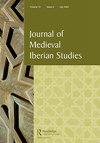向利奥卡迪亚墓唱歌:古西班牙仪式中独特的游行
IF 0.4
2区 历史学
0 MEDIEVAL & RENAISSANCE STUDIES
引用次数: 0
摘要
在整个古西班牙传统中,我们对圣徒游行的唯一记录是在圣莱奥卡迪亚的宴会上,在前往她的坟墓(ad sepulcrum)的路上唱的颂歌。在十世纪的León安提福涅抄录中,这首圣歌与利奥卡迪亚墓周围的仪式产生了共鸣,这可能可以追溯到她的埋葬地西哥特人的首都托莱多。这篇文章探讨了与Leocadia有关的游行活动的证据,它在不同时期可能是什么样子,以及它是如何在遥远的León被庆祝的。纠正了一些关于她的遗物向北翻译的误解——它们并没有像人们经常坚持的那样被转移到奥维耶多——我们仍然对León手稿中包含的ad sepulchrum颂歌存在疑问。也许再现与托莱多守护神有关的关键仪式是一种获取托莱多精神权威的方式,作为西哥特王国的前首都,以及想象中的古西班牙礼拜仪式的来源。本文章由计算机程序翻译,如有差异,请以英文原文为准。
Singing to the tomb of Leocadia: a unique procession in the Old Hispanic rite
ABSTRACT The only record we have of a procession for a saint in the entire Old Hispanic tradition is a chant sung on the feast of Saint Leocadia, on the way to her tomb (ad sepulcrum). Copied in the tenth-century León Antiphoner, this chant resonates with additional references to rituals around Leocadia’s tomb which may be traceable to the Visigothic capital of Toledo, her place of burial. This article explores the evidence for processional activity connected with Leocadia, what it might have looked like in different periods, and how it may have ended up being celebrated as far away as León. Correcting certain misconceptions about the translation of her relics northwards – they were not moved to Oviedo, as is often upheld – we are yet left with open questions as to the inclusion of the ad sepulchrum chant in the León manuscript. It may be that reproducing key rituals connected with Toledo’s patron saint was a way of capturing the spiritual authority of Toledo as the former capital of the Visigothic kingdom and the imagined source of the Old Hispanic liturgy.
求助全文
通过发布文献求助,成功后即可免费获取论文全文。
去求助
来源期刊

Journal of Medieval Iberian Studies
MEDIEVAL & RENAISSANCE STUDIES-
CiteScore
1.20
自引率
20.00%
发文量
24
 求助内容:
求助内容: 应助结果提醒方式:
应助结果提醒方式:


